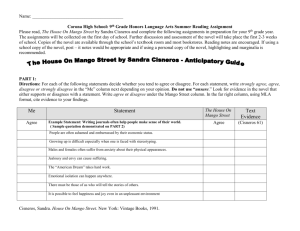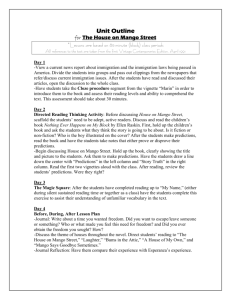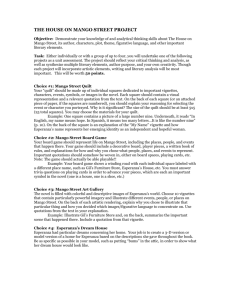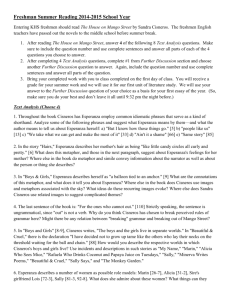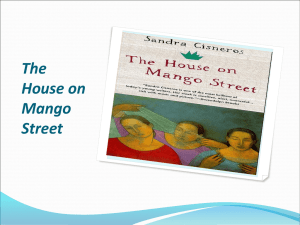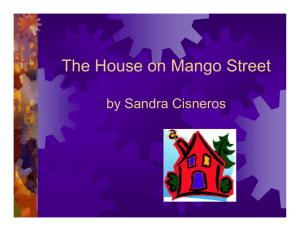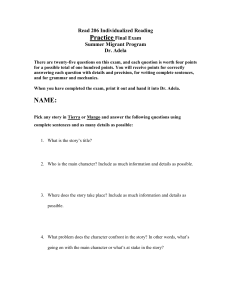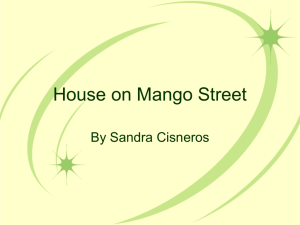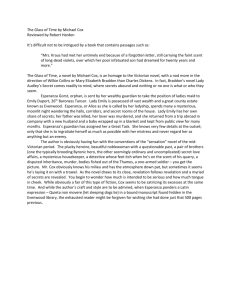HOMS_SandraCisneros - Bolsa Grande High School
advertisement
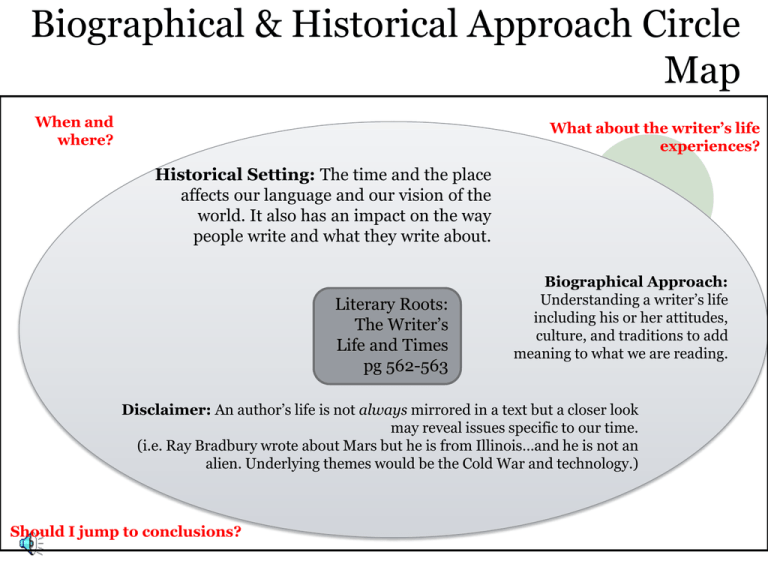
Biographical & Historical Approach Circle Map When and where? What about the writer’s life experiences? Historical Setting: The time and the place affects our language and our vision of the world. It also has an impact on the way people write and what they write about. Literary Roots: The Writer’s Life and Times pg 562-563 Biographical Approach: Understanding a writer’s life including his or her attitudes, culture, and traditions to add meaning to what we are reading. Disclaimer: An author’s life is not always mirrored in a text but a closer look may reveal issues specific to our time. (i.e. Ray Bradbury wrote about Mars but he is from Illinois…and he is not an alien. Underlying themes would be the Cold War and technology.) Should I jump to conclusions? C. Notes: Sandra Cisneros Identify background info. on the author. Born in the Hispanic Quarter of Chicago in 1954 (58 years old in 2012) Mexican-American (Chicana) She was the only girl in a family of seven, and grew up in poverty Her parents emphasized education Her family moved often; she was shy and introverted, but connected with her community privately through writing List 4 facts about her career. Attended Loyola University in Chicago as an English major Decided to become a writer Was afraid her unprivileged background would put her at a disadvantage in the literary world However, her heritage gave her the unique voice that shaped her career Define culture. The behaviors and beliefs of a particular social, ethnic, or age group. Examples: -social: the religious culture -ethnic: the Chicano culture -age group: the youth culture With your group, fill out the chart: Group social ethnic age Your example: Recognize the narrator of The House on Mango Street: The work is narrated by Esperanza Cordero, thirteen, a Chicana girl in Chicago. Although told in the voice of a young girl, it addresses mature subject matter. In English, Esperanza means hope, and also, waiting. This choice of name is significant in the novel: the character and her independence represent a way out of the slums. As she watches her neighborhood, she decides that she will not become like the women she knows, trapped and powerless in a man’s world. Highlight the setting and its effects on the narrator. Mango Street symbolizes both Esperanza’s ball and chain (holding her down) and her inspiration. In the beginning of the novel, she is disappointed with the house on Mango Street. She finds that she is not like the other residents of Mango, that she can and will find the strength to leave her life there. She realizes that Mango is a part of her, and where she comes from is as important as where she’s going. She knows she must come back, to help the others who are trapped there. Cisneros’ writing includes much imagery. She makes unexpected comparisons between things to give connotations to what she describes. Examine the structure of the novel. There is no real chronological plot, but a series of insights into Esperanza’s thoughts and feelings. The vignettes (snapshots) show the trends in behavior in the community and provide a contrast between strength and weakness, between freedom and confinement. Describe the significance of this novel. This is Cisneros’ first novel (published in 1984). It is a coming-of-age novel. It is a way to relate her cultural identity to her life and the lives of others. Cisneros seeks to break the cycle of oppression (hardships and suffering) that women experienced due to social and religious stereotypes by telling stories through the narrator Esperanza. Ticket out the Door! These questions will influence our unit and we will continue to return and reflect on them. Answer 2 sentences per question . Where does our sense of identity (who we are) come from? How does environment (surroundings) shape our identity? What identities, if any, are permanent and which do we have the power to change? What roles do neighborhood and community play in shaping who we become? Snoop Dogg Like a lot of famous rappers, Snoop grew up in squalor. His early days in Long Beach (a.k.a. the LBC) had him following the general career path of men in his neighborhood -– selling drugs. After a few short stints in jail, Snoop started making tapes with his friend who just so happened to be the step brother of Dr. Dre. The rest, as they say, is multimillion-dollar history! Jim Carrey Jim Carrey was born in Ontario, Canada. At first, Jim’s family was doing just fine. His father worked as an accountant, but as Jim got older, his family’s situation deteriorated. His family had to move to Scarborough and they all worked at the Titan Wheels Factory. Jim had to work eight hours a day and attend school. Still, it was very hard to keep the family stable. After moving out of the factory to new jobs, the family found themselves living in a camper van. Eventually, Jim had the courage to stand up and decide to act on his dream of being a comedian. He did stand-up routines and loved it, so much he dropped out of high school. Jim was able to land gigs and eventually got a part on a sitcom called The Duck Factory. He also became part of the In Living Color cast. This was a hit for him and he has since been able to play important roles in movies such as The Mask and Ace Ventura. Today he is one of the most highly paid comedians.
